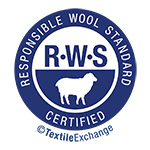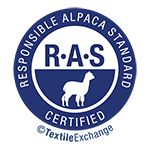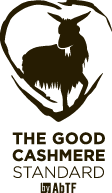Materials
Discover more about the materials we use. Each one is thoughtfully selected to embody the artistry of our design ateliers.
The Bast family is a group of fibres with the common denominator that their respective fibre is extracted from the inner part of the plant’s stem. They usually grow in cool and rainy climates requiring very little water to cultivate. Fewer fertilizers and pesticides are used compared to crops like conventional cotton.
LINEN
Linen is a natural and renewable fibre derived from the flax plant. Linen is breathable with moisture-wicking properties and a little bit more rigid than other fabrics. It is long-lasting and durable and becomes softer and more lustrous with use and laundering.
RAMIE
Ramie is a linen-like cellulose fibre made from the stalks of nettle plants. The Ramie fibre is a very strong, yet delicate fibre. It’s known especially for its ability to hold shape, and it introduces a silky lustre to the fabric’s appearance. Ramie is very absorbent and breathes well.
HEMP
Hemp is derived from the stems of the Cannabis sativa plant. The Hemp fibre is durable with high tensile strength and commonly used for rope, canvas, linens and apparel. The Hemp fibre resists abrasion and holds shape well, yet it gets softer with every wash.
Cotton is a natural and renewable fibre harvested from the cotton plant. Cotton is extremely versatile, soft, and breathable. It’s easy to dye and can be blended with a wide variety of other fabrics. PIMA cotton is one of the finest types of cotton with super soft properties. It is an extra-long staple fibre, which means that the fibre is longer than 34 millimetres. Since 2020 all the cotton we use is either, organic cotton, recycled cotton or cotton sourced through organisations like Better Cotton.
RECYCLED COTTON
Recycled cotton is made from textile that is mechanically recycled and spun into new yarn. The textile resources can either come from production scraps or end-of-life textiles. Our recycled cotton is traceable and verified by a third-party organization. In 2024, 10% of the cotton we sourced was recycled cotton.
ORGANIC COTTON
Organic cotton is grown without artificial pesticides or fertilisers and contains no genetically modified organisms (GMOs). In the process of growing organic cotton factors like fertility and biodiversity of the soil it’s grown in are taken into consideration. All our organic cotton is traceable and verified by a third-party organization. In 2024, 37% of the cotton we sourced was organic cotton.
IN-CONVERSION COTTON
In-conversion cotton comes from farms that are following a three-year program to convert their crop from conventional to organic. During this three-year period the farm follows the principles of organic cotton farming, meaning no artificial pesticides or fertilizers and genetically modified organisms (GMOs) are used. The farms are independently audited each year until the crop can be certified as organic. By using in-conversion cotton, we will help scale up organic production and support farmers in making the transition to organic cultivation. In 2024, our share of in-conversion cotton was 10%.
BETTER COTTON
Better Cotton is a non-profit organisation helping cotton growers convert to farming practices that offer longer-lasting economic, environmental, and social benefits, both at the farm level and in their local communities.
This type of cotton is sourced via a system of mass balance, meaning cotton from Better Cotton farmers may be mixed with conventional cotton in the manufacturing process. Cotton from this program is therefore not physically traceable. In 2024, 43% of our cotton was sourced through Better Cotton. By sourcing through Better Cotton, we are funding a global initiative that enables the organization’s training to reach more farmers and have a more profound impact.
Down has insulating properties creating warmth and at the same time it is lightweight and breathable. Feathers keep the down gathered and facilitate the evaporation of moisture. We use an 80% down and 20% feather combination in our padding. Our down & feathers are sourced from recycled sources. We never source down or feathers from exotic birds such as ostriches.
RECYCLED DOWN & FEATHERS
Recycled down, and feathers are recovered from end-of-life products such as duvets, pillows, or cushions. The recycled down & feather we use are traceable and verified by a third-party organization.
Leather is a very versatile and flexible material, created by tanning animal rawhide and skins. It’s also very durable and can last for a long time if cared for correctly.
We only accept leather originating from cows, buffalo, sheep, goats or pigs that have been bred for meat production. We do not accept:
• exotic skins or skins from wild animals
• leather or skin from fetal or newborn lambs
We are a member of the Leather Working Group (LWG), a multi-stakeholder community committed to building a more responsible leather industry. LWG sets standards for the leather manufacturing process, using different criteria including environmental and social sustainability, chemicals, and traceability. All the leather we use must be sourced from LWG certified tanneries.
LEATHER TANNING METHODS
Chrome-tanned leather is tanned using chromium sulphate and other chromium salts. However, there are environmental concerns related to waste management with this tanning method, as well as health concerns i.e. skin sensitivity.
By the end of 2025, all our leather used will be produced with a chrome-free tanning method. In 2024, 97% of our leather products used a chrome-free tanning method.
Chrome-free, or metal-free or vegetable tanned leather uses synthetic or vegetable extracts instead of chromium sulphate.
MIRUM®
MIRUM® is an innovative material made from natural rubber, plant-based oil, natural pigments, and minerals. MIRUM® is made from 100% natural materials and is plastic-free, providing an alternative to animal leather.
Man-made cellulosic fibres (MMCF) are a group of regenerated cellulosic fibres, usually made from wood. They can also be derived from other sources, such as agricultural, post-consumer and industrial by-products.
From 2025 all our man-made cellulosic fibres will be sourced from well-managed forests ensuring the protection of ancient and endangered forests and we have started to replace wood with next-generation fibres made from pre- and post-consumer textiles such as CIRCULOSE®.
CIRCULOSE® is an innovative material made from 100% discarded textiles, where cotton from worn-out clothes and production waste is recycled. It’s a dissolving pulp that can be used to make viscose, lyocell, modal, acetate, or other types of man-made cellulosic fibres. Conventionally, viscose is made from 100% wood pulp, so what is unique with CIRCULOSE® is that we, step by step, can start replacing the wood with textile.
VISCOSE
Viscose is smooth, absorbent, strong, and breathable, viscose is commonly used for a wide range of applications. Drapes nicely and has a lovely flow. Viscose is available in staple and filament fibres.
Staple fibre
Shorter fibres that are spun like cotton. The feel of staple viscose is also similar to cotton, typically soft and breathable. The most common staple fibres we use are Lenzing™ Ecovero™ and Livaeco™, trademarked viscose alternatives to conventional viscose. They derive their fibres from well-managed forests ensuring the protection of ancient and endangered forests.
Filament fibre
Filament fibre is one long thread like silk fibre. Therefore, also the look and feel of filament viscose reminds more of silk, resulting in a fibre with a soft and lustrous feel. The most common viscose filament fibre we use is Ecojilin and it’s made from cotton linter, instead of wood. The cotton linter is a discarded by-product from cotton fibre production and is the cotton fibres that are too short to spin. The linter is dissolved, processed, and then spun into a new fibre.
LYOCELL
Lyocell is a regenerated cellulose fibre commonly made from wood, but the raw material could also consist of other cellulosic materials. Unique physical properties lead to the high strength of the fibre, efficient moisture management and natural comfort.
TENCEL™ Lyocell is a trademark of Lenzing AG and is produced through a process which reuses 99,8% of the water and chemicals used.
MODAL
Modal is a very flexible fibre and therefore is known for its exceptional softness. Modal is a regenerated cellulose fibre commonly made from wood. We use Tencel™ Modal made from wood pulp from well-managed forests ensuring the protection of ancient and endangered forests. It is a trademark of Lenzing AG and used as an alternative to conventional modal.
CUPRO
Cupro fabrics breathe like cotton, drape beautifully, and look and feel like silk. Cupro is a regenerated cellulose fibre made from cotton linter instead of wood. The cotton linter is a discarded by-product from the cotton fibre production and is the cotton fibres that are too short to spin. The linter is dissolved, processed, and then spun into a new fibre.
ACETATE Acetate is a cellulosic material commonly made from wood, but the raw material could also consist of other cellulosic materials. It can be either a solid material or a textile fibre. Acetate textile fibres offer a brilliant colour impact with a luxurious lustre. The yarn transforms into soft fabrics with high comfort that are easy to care for. Available in filament (long) and staple (short) fibres. We use Naia™ made from wood pulp from well-managed pine and eucalyptus forests ensuring the protection of ancient and endangered forests. The fibre is traceable from tree to fibre. The production process is made in a system where solvents are recycled back into the system and reused.
Silk is known for its lustre and luxurious feel. It is a natural fibre sourced from the cocoons spun by silkworms. Silk is a very delicate and sensitive material, if cared for in the right way it can be very durable. Thanks to silk’s temperature-regulating properties, the fabric allows you to keep warm in the winter and cool in the summer.
ORGANIC MULBERRY SILK
With its pure white colour and refined texture, the mulberry silk is widely regarded as one of the finest. Produced by the Bombyx mori silkworms who feed on mulberry trees. Organic silk guarantees that the mulberry trees are grown according to the requirements of organic farming, free from artificial pesticides and other potentially harmful chemicals.
TUSSAH SILK
Spun by the Tussah silkworm, this wild silk possesses a natural golden tone and a rich texture. Tussah silk is mainly used in its natural form since it is difficult to dye.
RECYCLED SILK
Recycled silk derives from silk by-products in production, that are mechanically recycled and spun into new yarn.
POLYESTER
Conventional polyester is a synthetic fibre derived from fossil fuels. Recycled polyester is polyester made from PET bottles. The PET bottles are mechanically recycled and processed into new yarn. In 2024, 10% of the material we use is polyester and 92% is recycled.
POLYAMIDE/NYLON
Nylon is one of the most common polyamides we use and is a synthetic-derived fossil fuel. Recycled polyamide is made from materials like old fishing nets and carpets, as well as by-products from production. In 2024, 81% of the polyamide we used is recycled polyamide.
ACRYLIC
Acrylic is a synthetic derived from fossil fuel and starting 2025 we will stop using acrylic in our textiles.
Sourced from animals such as alpaca, goat and sheep, wool is a natural and renewable fibre with many benefits:
· Wool is highly breathable due to its ability to absorb and evaporate moisture.
· Wool has temperature-regulating properties, so the fabric allows you to keep warm in the winter and cool in the summer.
· Wool’s natural protective outer layer prevents stains from being absorbed.
Sheep and lamb’s wool is the most common wool that we use, it’s a natural, durable, and renewable fibre. We also use merino wool from the Merino sheep, which produces super soft and crinkly wool and it’s much finer than normal sheep wool.
From 1st of January 2025 all wool sourced by & Other Stories must be certified to either the Responsible Wool Standard (RWS), sourced from a third-party certified recycled source or sourced via the NATIVA Agricultural program.
RECYCLED WOOL
Recycled wool is made from production scraps or end-of-life textile waste. The scraps and end-of-life textile waste are mechanically recycled and spun into new yarn. In 2024, 8% of the wool we sourced was from recycled wool.
RWS – RESPONSIBLE WOOL STANDARD
The Responsible Wool Standard (RWS) verifies wool fibre animal welfare and land management requirements and tracks it from farm to final product.
& Other Stories is certified to the Responsible Wool Standard.
TE-00047206. Please look for the RWS hangtag to identify products with RWS Wool.

NATIVA™ REGENERATIVE WOOL
Regenerative agriculture is an umbrella term for a range of agricultural practices that aims to improve soil health, increase biodiversity, restore watersheds, and build ecosystem stability, also reducing CO2 emissions related to farming.
NATIVA™ wool is sourced using regenerative practices that comply with animal welfare standards, land management requirements and the Responsible Wool Standard (RWS), supporting farmers and their surrounding communities, while promoting improved soil health over time. NATIVA™ is currently driving a project that supports rural women, providing guidance, training and mentorship for their entrepreneurial projects - offering connection to women often isolated in rural areas and giving skills that promote financial independence.
In 2024, 15% of the wool we used is NATIVA™ regenerative wool.
RMS – RESPONSIBLE MOHAIR STANDARD
Mohair wool is a long, fine, and lustrous natural fibre from goats. All mohair used by & Other Stories must come from farms certified to the Responsible Mohair Standard (RMS).
The Responsible Mohair Standard (RMS) verifies mohair fibre animal welfare and land management requirements and tracks it from farm to final product.
& Other Stories is certified to the Responsible Mohair Standard.
TE-00047206. Please look for the RMS hangtag to identify products with RMS Mohair.

RAS – RESPONSIBLE ALPACA STANDARD
The alpaca produces a soft, durable, and silky wool fibre. It is light and hairy, but fluffier than mohair.
From 1st of January 2025 all alpaca sourced by Other Stories must be certified to the Responsible Alpaca Standard (RAS).
& Other Stories is certified to the Responsible Alpaca Standard.
TE-00047206. Please look for the RAS hangtag to identify products with RAS Alpaca.

CASHMERE
The cashmere goat produces a luxurious, natural fibre that is super soft, silky, and smooth.
All & Other Stories’ cashmere is verified under The Good Cashmere Standard® by AbTF or sourced from third-party certified recycled sources.
RECYCLED CASHMERE
Recycled cashmere is cashmere made from textile scraps in production or end-of-life textile waste. The scraps are mechanically recycled and spun into new yarn. In 2024, 37% of the cashmere we sourced was recycled cashmere.
GCS – GOOD CASHMERE STANDARD
The Good Cashmere Standard® is owned by the Aid by Trade Foundation (AbTF) and sets out requirements on animal welfare, land management and herders’ working conditions. In 2024, 63% of the cashmere we sourced is verified under The Good Cashmere Standard® by AbTF.
More info on GCS Cashmere:
www.thegoodcashmerestandard.org
